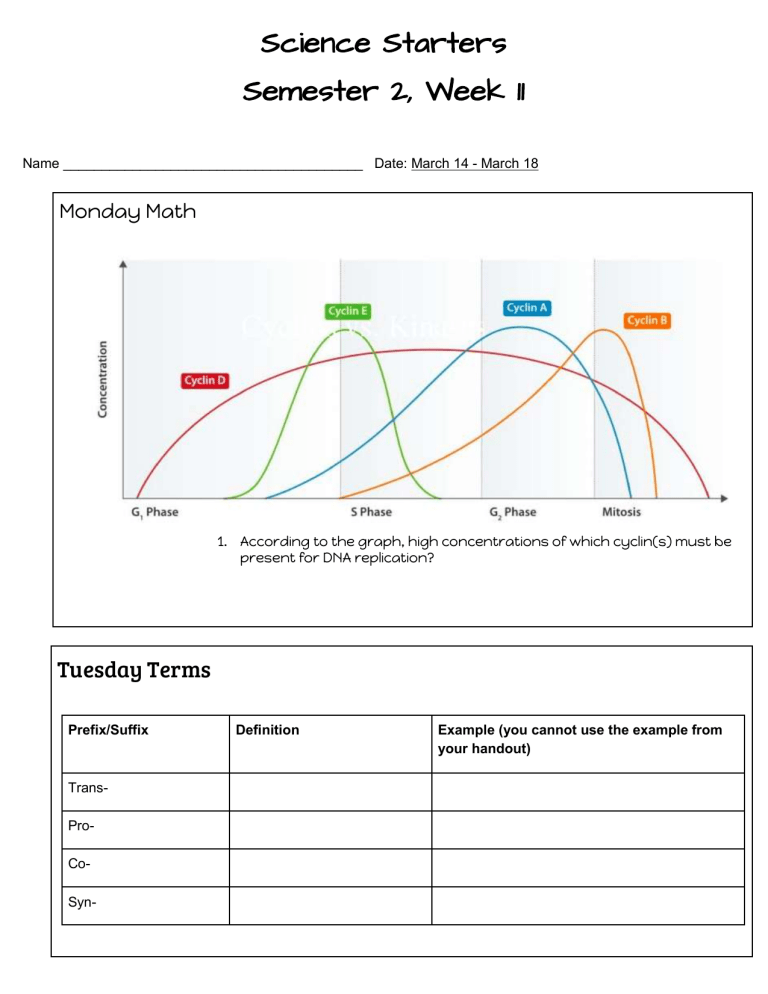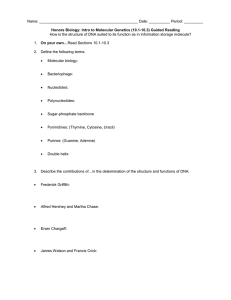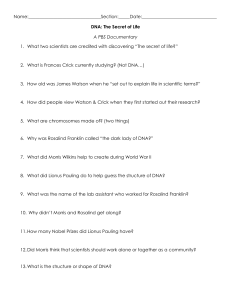
Science Starters Semester 2, Week 11 Name _______________________________________ Date: March 14 - March 18 Monday Math 1. According to the graph, high concentrations of which cyclin(s) must be present for DNA replication? Tuesday Terms Prefix/Suffix TransProCoSyn- Definition Example (you cannot use the example from your handout) Wednesday Writing, Word Connections Name and explain one scientist's contribution to the discovery of DNA being our genetic material. Thursday Thinking 1. In the Frederick Griffith experiment with the bacteria that causes pneumonia, which strain was the killer? 2. Which strain made you sick but mice were able to recover? Freak out Friday Three English Biochemists Unravel DNA to Unlock the Mystery of Life The competition to unravel DNA was one of the great scientific races of all time. The winners were three English scientists. The first was Rosalind Franklin. She worked at the University of London. The other two were James Watson and Francis Crick. They worked together at Cambridge University studying crystallography. Cambridge was just 50 miles away from Franklin. While studying DNA, Franklin became an expert in X-ray crystallography. She was able to produce clear and accurate images of DNA crystals. She used precise X-ray equipment and pure DNA samples. In 1952, Franklin made an especially clear X-ray image of a DNA crystal. At the time, she was studying the structure of DNA. Her co-worker, Maurice Wilkins, showed the image to Watson. He did not tell Franklin or ask her permission. Watson saw the image. He immediately knew that DNA was shaped like a spiral. He returned to his lab to begin making models out of metal and wire. Watson and Crick used models to try to visualize DNA. They experimented with different shapes. Franklin was working on developing better quality X-ray images. But Watson and Crick were racing against Pauling, of California, to discover DNA's structure. They felt making models would give an answer more quickly. Crick and Watson finally found their answer. They pictured DNA like steps on two spiral staircases. The bases bonded together in pairs. They made up the steps in the staircase. The ribose sugar made up the sides, or railings, of the stairs. They had found the secret of life. Crick and Watson published their discovery in Nature magazine in April 1953. In 1962, Wilkins, Watson, and Crick received the Nobel Prize for their work. Franklin could not share in the prize. She died in 1958 of cancer. She was just 37. Working with X-rays may have made her sick. She may not have shared in the prize even if she had lived. Crick and Watson never told Franklin they used her images. They didn't give her much credit in their Nature article. Watson later admitted that they could not have solved the problem without Franklin's work. 1. Do you think that Watson and Crick would have ever discovered the structure of DNA without Rosalind Franklin’s X-ray image? Why? 2. Do you think that she should have also received the Nobel Prize for her role in the discovery of the structure of DNA?

